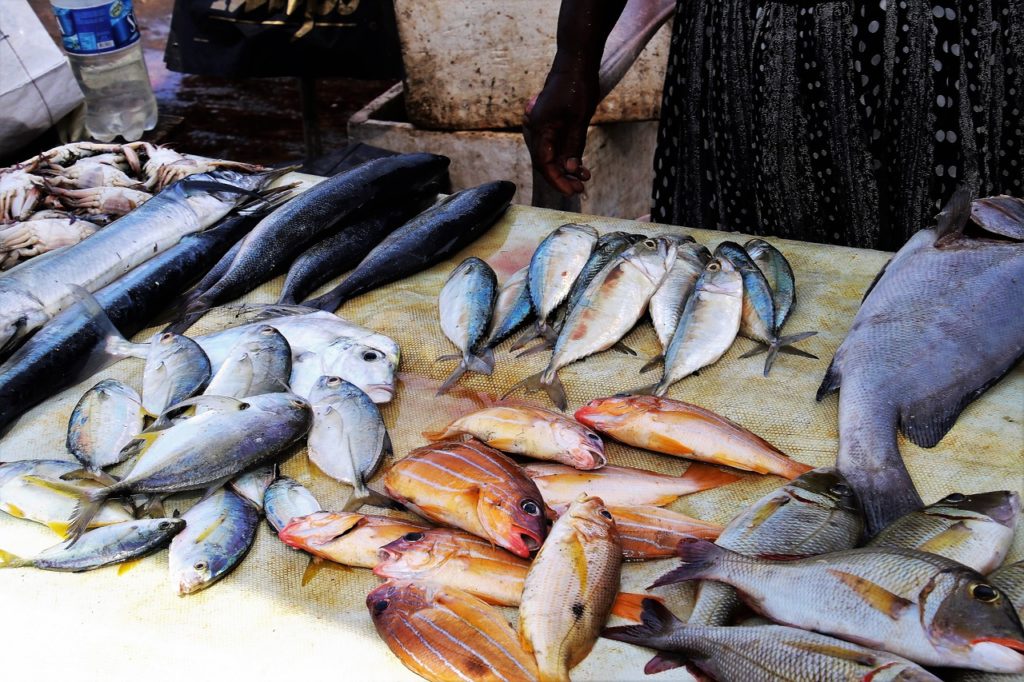What species of fish are you really eating when you buy a fillet at the grocery store or fried fish at your local restaurant? In the first picture below, it’s easy to tell that it’s a catfish, but how about in the second picture of fish and chips? Statistics on how often fish are labeled as a different species vary widely based on the type of retailer (market versus restaurant, chain versus single location) and the location of the study, but mislabeling is common practice . Whether or not mislabeling is intentional is hard to tell, because fish species can look very similar. Fishermen and processing plants don’t have a way to analyze individual fish’s DNA to identify it, so they have to trust experience.

Photo on left: Christmas Eve Dinner by Gary Stevens. Creative Commons 2.0. Photo on right: Photo by Midnight Believer, Public Domain. Image Source: Catfish & Fries, 2015
In the United States, the Food and Drug Administration inspects most seafood products to determine if they are labeled correctly, but catfish receive special treatment and are regulated by the United States Department of Agriculture Food Safety Inspection Services. In 1994, after embargos on Vietnam were lifted, the United States started importing Vietnamese catfish and the price of American catfish plummeted. Vietnamese catfish are members of the Pangasiidae family and are cheaper due to the fishes’ rapid growth rate and high fillet yield. To distinguish these from United States catfish, legislation was passed that required Pangasliidae species to be labeled “swai” or “basa”. To be labeled “catfish” in the United States, a fish has to be a member of the Ictaluridae family, which includes channel catfish and blue catfish.
Previous studies on catfish labeling showed that 3 out of 21 catfish products in the Northeastern United States and 4 of 15 catfish dishes at restaurants in the Southeastern United States were actually Pangasliidae. In contrast, the Food and Drug Administration found that all 40 fillets from a distributor in California were identified correctly as American catfish. Researchers from Chapman University and Santiago Canyon College wanted to determine the true amount of mislabeled catfish in Orange County, California.
To do this, the researchers purchased catfish products, such as fish and chips or frozen fillets, from 40 restaurants and 39 markets. They washed off any sauces and removed any batter, then extracted DNA by taking a sample from the center of each product. They tested these samples to determine whether they were indeed U.S. catfish, using a technique called real-time polymerase chain reaction. This technique involves mixing a DNA sample with chains of nucleotides that bind to specific segments of DNA that are only present in a certain species or group of species. These segments are then multiplied, which creates a detectable amount of material if the sample contains the DNA of the species being tested for. If there is no detectable material, then there was no matching DNA for the chains to bind to, meaning the sample was not from that species or group. If the sample failed the U.S catfish test, then the researchers tested if the sample belonged to the Vietnamese catfish family using the same method but with different chains of nucleotides. Any location that provided products that failed the U.S. catfish test was revisited a year later and the same products (if available) were re-tested.
According to their findings, 7 of the 80 products were mislabeled, of which 5 were from restaurants and 2 were from grocery stores. Deep-fried products were the most likely to be mislabeled, possibly because it’s hard to tell what kind of fish is used. The most expensive dishes, such as the baked fish at restaurants, were correctly labeled. This made sense because baked fish is served as a whole fish and therefore would be easily identifiable. The 2 mislabeled grocery store products were fresh fillets from seafood counters. Only 4 of the 7 products that had failed the test were still available for purchase the next year, and all 4 failed the re-test as well. These 4 products were all deep-fried dishes.
This study demonstrates that the Food and Drug Administration survey, which found no mislabeling of catfish at the wholesale level in California, does not give the full picture when it comes to catfish products being purchased by individual people. Perhaps if more consumers are aware of what types of catfish are most likely to be mislabeled, they can avoid being catfished by catfish.


